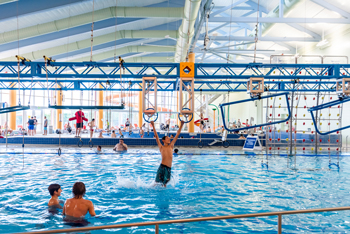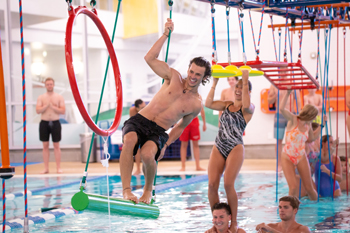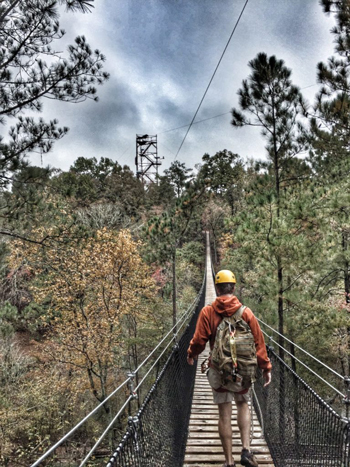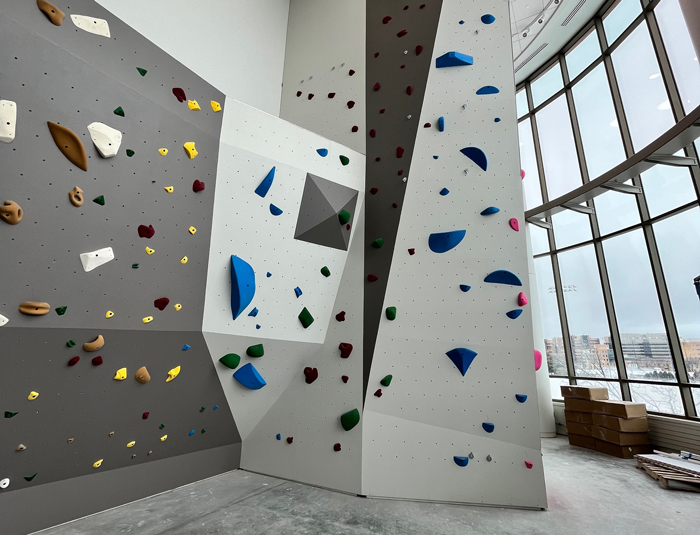The popularity of climbing and bouldering walls is not fading, and obstacle and ninja course excitement is rising.
Whether hosted by private companies or municipalities, for fun, fitness or corporate team-building, people who want to test themselves have no shortage of places to take part in what’s known as active entertainment. New construction and retrofitting feature the latest in climbing and bouldering walls, zip lines, ropes and ninja courses, in indoor, outdoor and aquatic venues.
The multiple challenges presented to users can be strictly to make money or to reward and retain members.
Entertaining—and Retaining—Members
Scott Henderson, parks and recreation director for Provo, Utah, said the latter reason sparked the acquisition of a ninja course that drops down from the rafters above the recreation center’s lap pool.
“Even though we’re operating a municipal recreation facility, we take this from the private sector and especially waterpark management—having new amenities every year so that gives, we call them ‘presents,’ to our members,” said Henderson. “It refreshes the facilities, and it adds excitement, and it adds a dynamic to the facility so that it’s ever-changing.
“We want to keep the Provo Rec Center new forever is our attitude. We do this by adding amenities, the latest in fitness equipment, the latest in aquatic equipment. (Members) perceive it as added value.”

The course in Provo was the first installed in the United States by its manufacturer, based on Overland Park, Kan. Installed four years ago, it added to an aquatic area that boasted a climbing wall under a waterfall, indoor and outdoor waterslides, and a zero-depth section.
Henderson said the use of unused space above the pool, its quick deployment and the ability for programmers to schedule its use even while lap swimmers share the area made it a no-brainer addition. The ninja course occupies the space above three lanes, and the pool’s no-wave lines ensure the course’s users dropping into the pool is no bother to swimmers doing laps.
“A lot of times we get stuck in aquatics thinking about a singular purpose going on in an aquatic environment, when you can have two or three activities going on in the same aquatic environment and they all get along quite well,” said Henderson. The ninja course “… has enough challenge and element of individual accomplishment that it brings in that teenage group that we find so hard to program to.”
During the school year, the center programs use of the course on evenings and weekends when the leisure areas are at maximum capacity. Henderson said the course needs a lifeguard at the start and finish. A timing element and adjustable challenges delivers the competitive element. The main necessity for the course is load-bearing structure.
The 162,000-square-foot center gets 2 million visitors a year and has about 25,000 members. With its commitment to refreshing itself regularly, adding an amenity that took up no space already in use or remodeling was crucial, Henderson said. “Who would have thought that 162,000 square feet may be not enough, so we have to come up with ideas to adapt our existing facilities to diversify use and expanded use to be able to handle our 25,000 members,” said Henderson. “We were experiencing such high use in our aquatics area—a competitive pool used for lap swimming, water exercise class, and swim teams—we had to add to that diversity in programming to be able to help in addressing our members’ needs for activities that they can participate in and handle some of the numbers we’re seeing.”
Kyle Regier, managing partner of the company that provided the ninja course, said they provide training and programing assistance, and can put the courses above outdoor pools, in indoor non-aquatic spaces, and in multi-course and mini versions. “Some of our clients have noted pool utilization increasing up to 30%; others have organized 300-person events and day-to-day have 20 to 30 guests who wait in line,” Regier said. “Because the system requires a skillset to develop, it’s a great mousetrap for operators who desire repeat usage, increased length of stay and the spectator crowd.
“Social media has been huge for streaming competitions and attracting eyeballs with a low-cost way to engage existing members or attract new ones.”
Destination: Adventure
Adventure activities can be one part of a multi-offering fitness facility or they can be the whole reason for a business to operate. Locations with multiple active entertainment offerings—adventure parks—are trending, and one of the gold standards in the field is Historic Banning Mills, near Atlanta. The nonprofit eco-space offers a variety of traditional outdoor activities, like nature trails, kayaking and horseback riding, but also boasts two Guinness World Records attractions: longest zipline canopy tour and tallest freestanding rock-climbing wall. There are also free-falls off a tower, ropes courses and suspension bridges that require personal protective equipment.

Thrills and risk require that safety be such a facility’s top priority, and Historic Banning Mills provides a glimpse into what that takes. Mateo Mancas, a manager at the facility, said because safety is so important in adventure activities, it is the area that has shown the most advances in recent years.
Mancas said that all safety standard progress has been in staff training, day-to-day maintenance and technology such as emergency arrest devices, continuous belay and smart belay systems for zip lines and ropes courses. The free-fall at his facility is not a bungee-cord-based attraction but a German device that controls the fall at nearly full velocity.
“With that welcomed change has also come challenges,” said Mancas. “These range from cost, communication of standards, and the lengthy process of switching out equipment. Price naturally increased with the necessity of extra safety measures. Some companies have had to do complete overhauls for new equipment, and with that comes the cost of equipment and time, and labor.”
Safety also goes hand-in-hand with maintenance of equipment. Mancas said there are daily inspections of all gear before and after tours, and staff has to ride the courses before any customer does. Electronic logging of usage and any problems happens at the end of each day.
Monthly periodic inspections involve trained in-house inspectors who “inspect every nut, bolt, cable and tree,” Mancas said. “These are then written up in detailed reports so we can later look back on and see what we need to do for maintenance. Our month-to-month maintenance consists of a lot of trail and tree upkeep and swapping out smaller pieces of hardware that tend to wear faster. We also look at our gear to confirm that none of it will expire in the upcoming month.”
Yearly inspections adhere to the Association for Challenge Course Technology requirement that all courses abide by manufacturers’ standards for inspection intervals. “From this, we can compare notes with another set of eyes on our course,” said Mancas. “It is a way to ensure that one, our internal maintenance and inspections are up to par, and two, there is accountability with someone. We also look at trends we have seen throughout the year and find out how we can adapt to be a safer and more efficient company.”
Staff gets as much safety attention as equipment, said Mancas. To become zipline guides and facilitators, prospective employees during the interview process are required to go on two zipline tours so hiring managers can assess how they work in the adrenaline-pumping environment. After that, they shadow experienced guides through several tours. “They get hands-on experience helping guests through the course, learning tips and tricks, and, most importantly, getting all safety procedures down,” said Mancas.
Once they have done those first two stages of training, they move on to a full one-day intensive course. During this course, they receive one-on-one instruction on all local operating procedures and all emergency procedures. At the end of the day, they take a cumulative test on all the training they have received during all stages of preparation. Once they have passed practical skills and written test, they are considered full-on zipline guides, said Mancas.
Because of the possibility of a need for first aid and emergency procedures, the facility’s staff must complete several continuing education programs offered throughout the year. These range from Wilderness First Aid classes to high ropes rescue refreshers and designated local operating procedure training days.
“We offer many ways for our guides to stay prepared for any situation,” said Mancas.

Adventure Park & Conservancy
Before the training and maintenance, an organization needs to choose and purchase the equipment which customers or members use. Scott Hornick is CEO of a firm that designs and manufactures various adventure park components—zip lines, ninja and ropes courses, rock climbing walls. Hornick said because of the high customizability of adventure park attractions, prospective clients have to help manufacturing and designing partners with some basics when they begin to inquire about working together.
“The question is, what are they trying to do?” said Hornick. “Is it a family park? Corporate team-building? Who’s using it? Little kids? Athletes? What’s the budget?
“It starts with two things: Where do you want to put this, and how much do you want to spend? What is the business model: a YMCA, or a gymnastics center dealing with higher-end athletes? We’re trying to understand how they’re going to use it, how they envision using it, so we develop the concepts around what they want to use, who’s using it, how they want to use it.”
Hornick said the busiest part of his business lately is ninja courses. The cost for these rises based on how closely the operator wants the course to resemble the TV show that kickstarted the craze, American Ninja Warrior. If an operator wants certain elements of the show’s courses—glitz, lights, aluminum trusses—the price naturally increases.
Hornick said operators on a smaller budget or with different priorities can get the same obstacles as the show courses for much cheaper simply by skipping the bling and using metal or wood instead of aluminum.
“It doesn’t look like the show, but the activities are identical,” he said. “At the end of the day it’s the same elements, just on a different playing structure to reduce the cost.”
Speaking of costs, across the adventure equipment industry they mostly rose in the past few years due to increased materials costs during the pandemic and subsequent inflation, and higher petroleum prices, which affected more than shipping expenses because of petroleum’s ubiquity in materials makeup.
“Gas prices have come back down, but (prices of) drums of chemicals have not,” said Nate Postma, who runs a manufacturer of climbing walls and accessories as well as six climbing gyms. “We’re all predicting they’re not going to.”
Up and Up
Postma’s unique dual roles make him specially placed to gauge the pulse of an industry that fared better than most public places during the pandemic. According to the Climbing Business Journal, only 3% of climbing gyms closed down in 2020, while 20% to 25% of general fitness locations suffered that fate.
At the same time, the sport got a boost when speed climbing debuted as an Olympic sport at the 2020 Tokyo Summer Games, held in 2021. While business was booming for Postma’s gyms just before the pandemic restrictions hit, he said his January 2023 numbers set a record. “We’re well on our way back,” Postma said.
The success of his Midwestern gyms prove that similar businesses do not need to be located in regions where climbing is a natural fit, like Western states, for example.
Postma said if inexperienced operators want to open a climbing gym or add a wall to an existing facility, they simply need to be committed and to use their smarts. “You don’t have to think hard, you just have to think,” he said. “You have to care, you have to want. Our psychographics don’t compare to people in Boulder, Colo., or Seattle, or Salt Lake City, Utah. What we recognized is, climbing is fun, and when given a chance and a person knows about it and gets a chance to try it, some of them will like it and they will come back.
“We focused on programs to build that market, to build those customers. We didn’t have the psychographics of those key regions, but we made it work anyway by marketing, marketing, marketing.”
Postma said wall operators should start by calling organizations with youth groups, like churches, and Boy Scouts and Girl Scouts. Both of the latter give merit badges for climbing. “Let the world know you have this climbing wall and it’s available,” Postma said.
Hiring the right staff requires the same approach, Postma said. Working at a climbing gym is fun, he said, so pay well, and the combination will drive the retention so crucial for a safety-based environment.
“If you pay $6 an hour, you’ll have turnover every six weeks,” he said. “The safety suffers and could lead to maybe lawsuits and then the powers that be question everything. If a climbing wall gets built and it doesn’t work, upper management was reluctant, there was an incident, they didn’t keep the staff or routes fresh and vibrant and didn’t do any marketing. You have to be committed to it.”
One Louisville, Colo.-based manufacturer of climbing walls partnered with Paradox Sports, a nonprofit dedicated to expanding adaptive climbing opportunities, to create new climbing structures that take the activity away from more traditional walls by providing freestanding and suspended columns in many different shapes and on which many different components and holds can be placed and removed for variety.
This sort of flexibility is what clients these days are interested in above all other considerations, said Jerad Wells, director of international sales and business development for the manufacturer. “How can the walls be used to support other programs, camps, corporate events, birthday parties and so on?” Wells said. This flexibility explains why the structures are increasingly being added to climbing wall designs, along with adaptive climbing lanes, he said.
Wells said operators in search of design and manufacturing partners should look for a track record of successful projects completed on time and on budget, as well as passion for the sport and operating experience. “It’s one thing to build a climbing wall, but it’s a whole other thing to operate one,” he said. “It starts with knowing the project goals. Consideration for how the wall will be used, programed and staffed are other key components of a successful partnership. Having that firsthand operational experience from your wall builder will help ensure you get a wall that will perform to your needs and expectations.”
The University of Wisconsin-Madison will open one of the nation’s newest walls this spring when the Bakke Recreation and Wellbeing Center opens. It will feature the campus’s first wall and bouldering area, the use of which will be free to students and fee-based for non-student community members.
Erik Jaeke, associate director of programs for the university’s Recreation & Wellbeing department, said the project’s manufacturing and design partners as well as other industry groups have been invaluable resources in all aspects of the climbing and bouldering launch.
“We’ve heard from seasoned climbers in UW’s Climbing Club who are interested in practicing and competing on the wall, and we’ve also heard from several non-climber students who can’t wait to see the space and learn how to climb,” said Jaeke. “We can’t wait to get started.” RM



